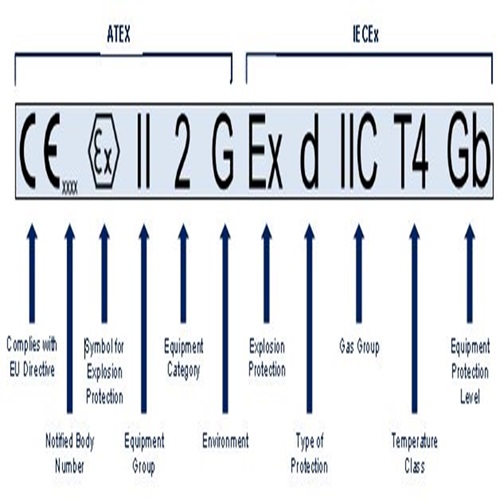ATEX Certificate Marking Structure
To identify and sell explosion-proof goods, the manufacturer must determine the marking of explosion-proof goods based on the technical requirements of the buyer when completing the application for ATEX certification.
equipment protection level (EPL) |
Temperature Class |
Gas or Dust Group |
Type of Explosion Protection |
product category |
product group |
Hexagon arm |
|---|---|---|---|---|---|---|
(6) |
(5) |
(4) |
(3) |
(2) |
(1) |
The information in the small two-column table below, on the left side of the main "Explosion-proof Product Marking Structure " table, includes
-
Flammable atmosphere;
-
Zone classification.
The two above items are not considered as a part of the explosion-proof product ATEX marking structure.
In fact, the small table is just to clarify the types of explosive hazardous zones.
To view the above tables in larger size, click on them.
1- Product group
-
Group I: the equipment which are used in underground areas or mines;
-
Group II: the equipment which are used in above ground areas (including onshore and offshore areas)
2- Product categories
The below classifications specify the hazardous area (zone) in which the product is mounted and operated.
-
Gases: 1G (Zone 0), 2G (Zone 1), 3G (Zone 2)
-
Dust: 1D (Zone 0), 2D (Zone 1), 3D (Zone 2)
3- Type of Explosion Protection
-
Ex e - Increased safety
-
Ex d – Protection for explosion-proof enclosure
-
Ex i – Intrinsic safety
-
Ex p – Protection for pressurized enclosure
-
Ex q – Protection for powder-filled apparatus
-
Ex o – Protection for equipment by immersion in non-flammable liquids
-
Ex nA – Protection for non-sparking equipment
-
Ex nC – Protection for enclosed spark-producing equipment
-
Ex nR – Protection for restricted enclosures to prevent the ingress of flammable gases and vapors
-
Ex m – Protection by encapsulation
-
Ex t – Protection for equipment against flammable dust
4- Gas / Dust Group
-
Gas Group (II): Includes
-
IIA (Methane);
-
IIB (Ethylene, Propane, Butane);
-
IIC (Acetylene, H2S);
-
Special gases (e.g., Hydrogen, marked as IIB+H2).
-
-
Dust Group (III): Includes
-
IIIA (flammable fibers);
-
IIIB (non-conductive dust like sulfur, wheat flour, wood flour, pharmaceutical particles);
-
IIIC (conductive dust like metal vapors).
-
5- Temperature Class
Temperature classes for gases (from T1 to T6)
The temperature class is determined according to the amount of maximum surface or service temperature on the basis of above table which specifies the corresponding between temperature classes and temperature range relevant to maximum surface or service temperature.
For instance, the equipment having a maximum surface or service temperature between 85°C to 100°C falls into temperature class T5.
Temperature classes for dust (from below 85°C to below 450°C)
To determine the maximum surface temperature for particles, instead of the temperature class that is used in gases, the surface temperature of the equipment in the worst operating conditions (which is often the full load mode at the maximum ambient temperature) is considered as a basis.
For example, if the surface temperature of equipment in a dust environment in the conditions that the maximum operating mode is equal to 180 °C, the same temperature of 180°C is inserted in the marking.
6- equipment protection level (EPL)
Protection level for gas environments:
-
Ga : Protection level for equipment operating in Zone 0
-
Gb : Protection level for equipment operating in Zone 1
-
Gc : Protection level for equipment operating in Zone 2
Protection level for dust environments:
-
Da – Protection level for equipment operating in Zone 0
-
Db – Protection level for equipment operating in Zone 1
-
Dc – Protection level for equipment operating in Zone 2
Relation between equipment protection level (EPL), equipment grouping based on the IECEx system, equipment grouping, and categorization based on ATEX directive, and the hazardous zone atmosphere of equipment operation is described in below table:
To clarify and better understanding the relation between some marking characters for explosion-proof equipment, Table ZY.1 from the EN 60079-0:2018 standard is provided above which accordingly:
-
Equipment with protection levels Ma and Mb are classified as Group I equipment, in categories M1 and M2, and are used in Group I gas atmospheres.The zone or hazardous area classification does not apply to equipment with protection level M.
-
Equipment with protection levels Gb, Ga, and Gc are classified as Group II equipment, in categories 2G, 1G, and 3G, and are used in Group II gas atmospheres.
-
Equipment with protection levels Db, Da, and Dc are classified as Group III equipment, in categories 2D, 1D, and 3D, and are used in Group II gas atmospheres.
Selecting the Hazard Zone for Explosion-Proof Equipment Operation
Equipment used for a specific area is selected based on the type or types of protection considered in their design.
Not all protective techniques guarantee the same level of safety in a hazardous area, therefore specific protection methods are allocated to particular hazardous zones.
-
IEC 60079-10-1 is used for identifying, classification, and categorizing hazardous zones for gas atmospheres;
-
IEC 6079-10-2 is used for identifying, classification, and categorizing hazardous zones for dust atmospheres.


.jpg)
.jpg)
